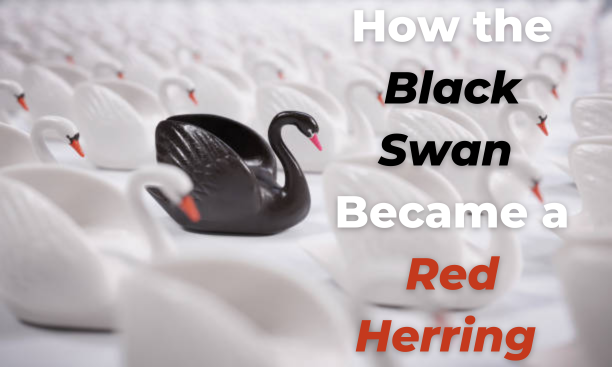As far back as Juvenal in the 2nd century, and for fifteen centuries on, the black swan was a metaphor for something that will never happen. Throughout Europe, it was like a “flying pig” today. But the black swan took on new significance in 1667, when Dutch sailors found them in Australia. Ever since, this exception to such a widely accepted uniformity has been a token for the uncertainty of scientific knowledge.
The story of the black swan becoming an icon of doubt begins with Francis Bacon’s campaign to change the study of natural phenomena from an intellectual process to something more dependent on observation. Part of his proposed empirical method was the idea that the characterization of regularly observed phenomena, like the sun rising every day, could be the basis for useful and reliable predictions. It is said to be the beginning of the “scientific method.” The discovery of black swans 41 years after Bacon’s death demonstrated conclusively that ‘consistently unobserved’ may not be the same as ‘impossible.’ In which case, no “law of nature” could be exempt from the occurrence of an exception.
Our inability to logically demonstrate what science is certain has left us with provisional arguments for trust based on the consensus of experts, the eventual self-correcting “scientific method,” and the point that informed opinion is superior to conjecture. Those negatively affected use this wedge of uncertainty to postpone assuaging the causes of climate change, environmental devastation, and pandemics “until we know for sure.”
But the methods of science have evolved since Bacon’s time. We don’t just rely on the consistency of observations. No reputable journal would accept a submission about swans necessarily being white if its only basis was a lack of contrary evidence. We would require the extent of the study and a rationale for its conclusion. So could a modern scientific approach to uniformities help us determine what is certain and what could change? Let’s see.
Just as Bacon envisioned, scientists formalize observations into “laws” which are equations or logical statements from which one can make predictions. Examples are the gas law relating pressure, volume, and temperature of a container of gas, and Newton’s law relating force, mass, and acceleration. We apply these laws widely and successfully, but what about possible “black swan” exceptions? A fact, well-known to experimental scientists, is that we already have some. The gas law only works for ideal gases and Einstein’s relativity shows that Newton’s law fails with rapidly moving objects. Most scientific laws have known conditions or limits beyond which they fail. But these exceptions don’t seem to interfere with their reliable implementation. Why they work reliably is the crucial point.
Scientific laws are dependable because they are within the limits of their verified applicability. Karl Popper called exceptions “falsifications,” suggesting they make a law invalid. But we would only find such exceptions under unverified conditions, such as the color of swans in untested parts of the world.
From a more positive perspective, limits define the conditions within which a law is entirely and consistently trustworthy. Stephen Weinberg points out, “...relativity…did not make Newton’s work a mistake, or revive Descarte’s. Just the opposite–relativity theory explained why Newton’s theory works, when it does work.” Exceptions often help clarify the basic process as well as stipulate boundaries of certainty.
The realist branch of philosophers (including Worrall, Putnam, and Ladyman claim that some science must be certain. They argue that the success of science would be a miracle were there not some aspects that represent reality. In fact, one definition of the word ‘miracle’ is “an event that is inexplicable by natural or scientific laws.” From the above discussion, we see that laws applied within limits of tested conditions could be the “aspects" the realists refer to. Going back further, they are Poincaré’s traces of disproved theories that still remain[1].
Because laws used under tested conditions are certainties, we can trust their predictions. Applying them in policy decisions is not just prudent; the forecast consequences of action or inaction will be real.
But as indicated above, scientific knowledge is not just its laws. We also want an explanation for why nature acts that way. We all need to make sense of observations. As Hofstadter and Sandler say, “At every moment of our lives, our concepts are selectively triggered by analogies that our brain makes without let-up to make sense of the new and unknown in terms of the old and known.”
Explanations for the observations we make are essential. As analogies or metaphors, they help us imagine or picture the phenomenon, they suggest other aspects to study, and they add to the fabric of knowledge through links to other explanations. But explanations are also the parts that, in the face of new observations, are either supported, revised, or replaced. Their value is not their truth but in their usefulness. Not realizing this, we have often wrongly declared a theory or concept totally invalid when it is just the explanation that has been disproved or a new limit discovered. What has changed is not what happens, but our understanding of why it happens.
The black swan is often considered a refutation of Bacon’s inductive reasoning and his approach thus deemed problematic. But it is doubtful that Bacon would have used the black swan as an example of a valid inductive conclusion. In Novum Organum, Bacon says, “In forming our axioms from induction, we must examine and try whether the axiom we derive be only fitted and calculated for the particular instances from which it is deduced, or whether it be more extensive and general.” Note his use of “particular instances” i.e., tested conditions. He had it all along.
The black swan token of uncertainty was actually a red herring; one that has distracted us from finding true confidence in scientific knowledge ever since. Let’s get over it and trust the science we already use while looking forward to what further study will reveal.
[1] Author’s Preface, xxi

